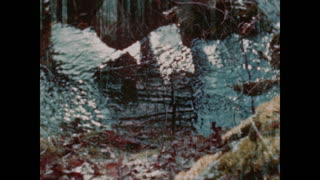Directed by Richard Lyford, “Dead Out” is a forest fire prevention film sponsored by the Forestry Department of the Twelve Southern States and the U.S. Department of Agriculture and Forest Service (:24). It tells the tale of a timber cruiser as he moves through the southeastern states researching wildfires and their causes. (Note: A timber cruiser is in charge of measuring forest stands to determine stand characteristics, to obtain a volume estimation to appraise and prepare timber sales.) Safe brush burning methods are shown. The USDA was formed by an act of Congress in 1905 during Theodore Roosevelt’s administration at the peak of the Progressive Era.
Filmmaker Richard Lyford worked for the First Motion Picture Unit during WWII and later made non-fiction films for Walt Disney, and for industry. He is best known for “The Titan”, a portrait of Michelangelo that won an Oscar.
The areas covered span Virginia to Texas (1:18). A woman works at a well in mountain country (1:44). African American or Black loggers cart sliced wood from the forest fresh cut (1:48). Crews (1:59) drill holes into turpentine trees (1:59). Donkeys drag carts of hardwood over the bottom lands (2:17). Towns folks mingle near signs for South Carolina’s main drag (2:22). Religious wander from white chapel churches (2:27). Remnants of country home stick up over land; only the chimney remains after a brush fire (2:42). The timber cruiser visits the home of the McDowell’s (2:56). The film shows the family’s efforts in up keeping the farm prior to the fire. He runs over dirt with a mule (3:02), churning up fresh earth. The mother and son pick apart crops from harvest (3:30). A young girl sets her Betty Lou doll next to a tree trunk (3:35). A burning sunset follows (4:02). Fires tear up the earth (4:10). The camera runs down the lone brick chimney stump left behind (4:17). The doll lay charred on the ground (4:44); his property and family suffered great injury. Small stores line the drag (4:48). News spread of the fire into town. The Forestry Department investigator enters the home of the McDowell’s cousins (5:20). McDowell interviewed (5:36) about his daughter. He recounts the events which lead to the fire (6:01). The investigator uncovers the origins of the fire (6:43). A fire is shown as an African American or Black woman washes clothes (7:07). Wet clothes are stuck on the line (7:17). The uncontrolled fire spreads (7:35) with ease over the dry brush (7:41). A cotton farmer burns a strip of grass around his cotton farm (8:04). Larry unintentionally destroys his woods (8:15) in the effort. The stubborn bull weevil remains (8:22). McDowell returns to his farm for spring planting (8:43). Rich recounts the events leading to the fire (9:15). A farm hand plows a fire line around the field on a windless day (9:44). Horse and plow burn brush (9:58). He notes the wind picked up later in the evening (10:24). Stacks burn (10:12). Young Betty Lou runs from the farm house (10:34). Fires erupt (10:41) and her doll lay charred on the ground (10:41). Animations explain (10:50) proper weather conditions for safe brush burning. A farm hand grasps at fresh dirt; the best time for a burn is after a good rain (11:26). The Ranger’s office should be informed before burning starts (11:36). Farming tools (11:52); including axe and a rake highlighted. A corner of the brush is ignited (12:16); smoke billows out. More brush added (12:22). Feed the fire slowly (12:32). The area is mopped up (12:44) with a rake; fires are sufficiently snubbed out. The farmer checks the dry land (13:18) ensuring it is ‘dead out’. Lumberjacks saw tree logs (13:36). A table saw slices off the bark of a stump (13:42). Carts tug away fresh cut wood (13:48). Statistics of fires from the year before are relayed (14:07). Loss is calculated (14:26). Construction workers prepare a foundation for a new farm home (14:58). The End (15:28).
Motion picture films don’t last forever; many have already been lost or destroyed. For almost two decades, we’ve worked to collect, scan and preserve the world as it was captured on 35mm, 16mm and 8mm movies — including home movies, industrial films, and other non-fiction. If you have endangered films you’d like to have scanned, or wish to donate celluloid to Periscope Film so that we can share them with the world, we’d love to hear from you. Contact us via the weblink below.
This film is part of the Periscope Film LLC archive, one of the largest historic military, transportation, and aviation stock footage collections in the USA. Entirely film backed, this material is available for licensing in 24p HD, 2k and 4k. For more information visit http://www.PeriscopeFilm.com


